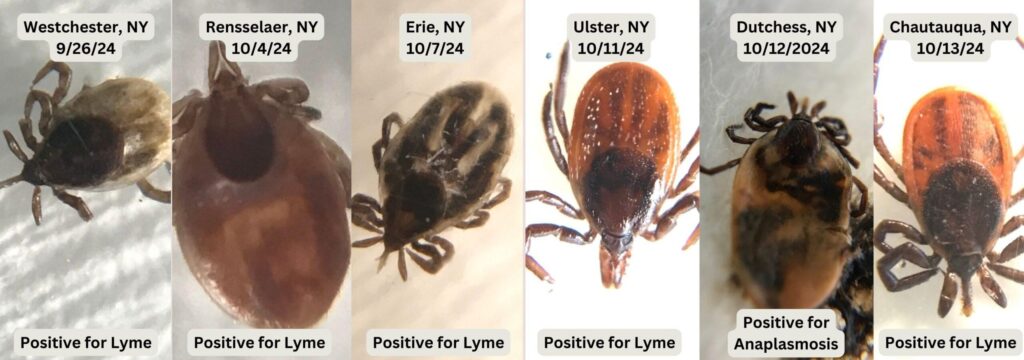New York Faces Unprecedented Tick Population Boom: What You Need to Know
Rapid Expansion of Tick Populations in New York Sparks Health Warnings
Across New York State, officials are raising urgent alarms as tick numbers have surged to record levels, creating a significant public health concern. This dramatic increase is largely driven by a combination of milder winters, rising deer populations, and expanding suburban areas that bring humans into closer contact with tick habitats. These factors have created ideal conditions for ticks to multiply rapidly, increasing the likelihood of transmission of serious diseases such as Lyme disease, Anaplasmosis, and Babesiosis.
Health authorities are emphasizing the importance of preventive actions to reduce tick encounters. Recommended precautions include:
- Wearing protective clothing like long pants and sleeves when outdoors
- Applying EPA-approved insect repellents formulated to repel ticks
- Conducting meticulous tick inspections on skin and clothing after spending time in wooded or grassy areas
- Maintaining tidy yards by trimming grass and clearing leaf debris regularly
Public education campaigns are intensifying to inform residents about early warning signs of tick-borne illnesses and the importance of seeking prompt medical care.
| Disease | Typical Symptoms | Standard Treatment |
|---|---|---|
| Lyme Disease | Fatigue, fever, characteristic rash | Antibiotic therapy |
| Anaplasmosis | Muscle aches, headache, chills | Antibiotics |
| Babesiosis | Fever, sweating, anemia | Antimicrobial medications |
Understanding Tick-Borne Diseases: Symptoms and Early Warning Signs
The surge in tick activity has heightened the risk of several tick-borne illnesses in New York. Experts caution that these tiny arachnids can transmit not only Lyme disease but also other serious infections such as Babesiosis, Anaplasmosis, and the rare but dangerous Powassan virus. Early recognition of symptoms is crucial since many signs overlap with common viral infections, making diagnosis challenging.
Residents should be alert for the following symptoms after potential tick exposure:
- Sudden fever and chills
- Persistent fatigue and muscle soreness
- Headaches and neck stiffness
- Rashes, particularly the distinctive bull’s-eye pattern
- Joint discomfort or swelling
Since the hallmark Lyme disease rash does not always appear, awareness of other symptoms is vital. Prompt medical evaluation and treatment can prevent severe complications.
| Disease | Incubation Period | Primary Symptoms |
|---|---|---|
| Lyme Disease | 3 to 30 days | Fatigue, rash, fever |
| Anaplasmosis | 5 to 14 days | Fever, headache, muscle pain |
| Babesiosis | 1 to 4 weeks | Chills, fever, sweating |
| Powassan Virus | About 7 days | Confusion, seizures, fever |
Recommended Safety Practices for Outdoor Activities Amid Tick Surge
With tick populations reaching unprecedented levels, New York health officials strongly advise residents to adopt comprehensive safety measures when engaging in outdoor activities. The proliferation of ticks in parks, hiking trails, and suburban neighborhoods is linked to recent weather patterns that favor their growth and spread.
Key precautions include:
- Wearing light-colored, long-sleeved shirts and pants to spot ticks more easily
- Using insect repellents containing DEET or Picaridin for effective tick deterrence
- Performing thorough tick checks on yourself, children, and pets immediately after outdoor exposure
- Keeping lawns well-maintained by regularly mowing and removing leaf litter to reduce tick habitats
Local governments are also intensifying tick control efforts and public education to mitigate risks.
| Precaution | Details |
|---|---|
| Clothing | Wear light-colored, long-sleeved shirts and pants |
| Repellent | Apply EPA-approved insect repellents with DEET or Picaridin |
| Tick Checks | Inspect yourself, family members, and pets after outdoor activities |
| Yard Maintenance | Keep grass trimmed and remove leaf litter regularly |
Community Initiatives Strengthen Efforts to Manage Tick Populations and Educate the Public
In response to the alarming rise in tick numbers, local communities and municipal agencies have launched coordinated programs aimed at controlling tick populations and raising public awareness. These initiatives include targeted pesticide treatments, habitat modification, and educational outreach designed to minimize tick habitats around homes and public spaces.
Community-driven efforts focus on clearing brush and leaf litter, which serve as prime tick environments during warmer months. Additionally, free tick identification clinics and informational workshops are being offered to empower residents with knowledge on prevention and early detection.
Schools and community centers have integrated tick safety education into their programs, teaching practical steps such as wearing protective clothing, using repellents, and conducting regular tick checks after outdoor play or work.
| Program | Description | Audience |
|---|---|---|
| Tick Control Workshops | Training on pesticide use and habitat management | Homeowners, landscapers |
| Public Awareness Campaigns | Distribution of educational materials and social media alerts | General public |
| School Education Programs | Curriculum on tick biology and prevention | Students and teachers |
| Neighborhood Clean-Up Events | Community efforts to clear brush and reduce tick habitats | Local residents |
Conclusion: Staying Prepared Amid New York’s Tick Population Surge
As New York confronts an extraordinary increase in tick populations, public health experts stress the importance of vigilance and proactive prevention. With tick-borne diseases on the rise, awareness, early detection, and adherence to recommended safety measures are essential to protect individuals and communities. Staying informed and prepared will be critical in managing the challenges posed by this significant uptick in tick activity.













